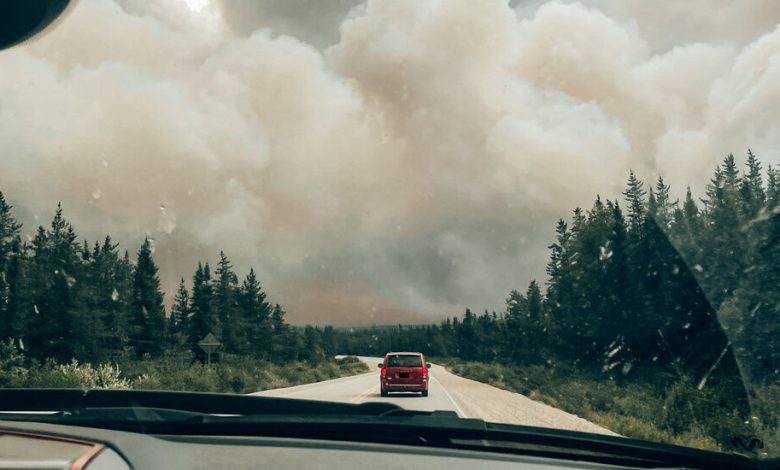Warming Set the Stage for Canada’s Record Fires, Study Finds

Hot, dry and gusty conditions like those that fed this year’s wildfires in eastern Canada are now at least twice as likely to occur there as they would be in a world that humans hadn’t warmed by burning fossil fuels, a team of researchers said Tuesday, providing a first scientific assessment of climate change’s role in intensifying the country’s fires.
So far this year, fires have ravaged 37 million acres across nearly every Canadian province and territory. That’s more than twice as large as the amount of Canadian land that burned in any other year on record. Tens of thousands of people — including most of Yellowknife, the capital of the Northwest Territories — have fled their homes. Smoke has turned the air toxic in cities as far south as Atlanta.
Wildfires can be ignited by lightning or human-related causes such as unattended campfires, downed power lines and arson. The way fires spread and grow is shaped by the structure and composition of the forests and landscape. But heat, rain and snow affect how flammable the trees and brush are, which can determine how intensely blazes burn and how tough they are to put out.
In an analysis issued Tuesday, researchers with the World Weather Attribution initiative estimated that eastern Canada now had a 4 to 5 percent chance, in any given year, of experiencing high-fire-risk conditions as severe or worse than this year’s. This likelihood is at least double what it would be in a hypothetical world without human-caused climate change, they said. And the probability will increase as nations blanket the planet with more heat-trapping gases.
“Fire-weather risks due to climate change are increasing,” said Dorothy Heinrich, a technical adviser at the Red Cross Red Crescent Climate Center who worked on the analysis. “Both mitigation and dedicated adaptation strategies are going to be required to reduce the drivers of risk and decrease its impacts on people’s lives, livelihoods and communities.”
World Weather Attribution aims to estimate, shortly after a heat wave, flood, drought or other extreme weather event, how human-caused warming has altered the chances that events of such severity will occur. Scientists do this by using computer models of the global climate to compare the real world with a hypothetical one that hasn’t been transformed by decades of greenhouse gas emissions.
When researchers with the group examined Australia’s deadly wildfires of late 2019 and early 2020, they calculated that the exceptional warmth and dryness that preceded the blazes was at least 30 percent more likely to occur there than it would be in a world without global warming.
As is typical for World Weather Attribution, the analysis of Canada’s fires is being made public before being submitted for academic peer review. Most of the group’s research is later published in peer-reviewed journals.
Their latest analysis focused on northern Quebec, where fires in June alone burned nine times as much land as in the previous decade combined. The region’s wetter climate makes it less accustomed to large wildfires than the country’s West.
The researchers looked at the Fire Weather Index, a metric that includes temperature, humidity, wind and precipitation. They estimated that a Quebec fire season with a peak intensity, a rough gauge of how quickly fires can spread, like this year’s was at least twice as common as it would be without global warming. And a fire season with a cumulative severity like this year’s, a potential measure of how much land is burned in total, is seven times as common, they said.
They cautioned that these were conservative estimates. “The real number will be higher, but it’s very difficult to say how much higher,” said Friederike Otto, a climate scientist at Imperial College London who also contributed to the analysis.
Canada’s fire season isn’t over. More than 1,000 fires were raging there this week, most of them uncontrolled. British Columbia has been under a state of emergency as fires threaten areas near cities including Kelowna and Kamloops.
In Quebec, many forests where timber was recently harvested may be too young to regenerate after the flames are out, said Victor Danneyrolles, a forest ecologist with joint appointments at the University of Quebec at Chicoutimi and the University of Quebec at Abitibi-Témiscamingue.
Dr. Danneyrolles, who wasn’t involved in World Weather Attribution’s analysis, said the group’s findings didn’t surprise him. In a 2021 study, he and several colleagues found that climate fluctuations were the dominant factor behind the amount of land in eastern Canada burned by wildfires between 1850 and 1990. Climate had greater influence, they found, than the region’s populating by settlers of European origin, who burned land to clear it for farming.
Today, rising heat and dryness appear to be altering fire patterns once again, Dr. Danneyrolles said.
“If a year like 2023 becomes something which comes back every 20 years, then the system will be in a completely new era in terms of fires,” he said. “It’s something that hasn’t been observed during the last century, maybe not in the last thousand years.”



